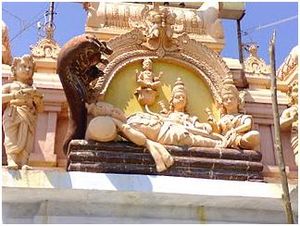Dhevadhaanam Sri Ranganathar
Dhevadhaanam is located close to Minjur near Chennai. It is a very small, undisturbed and unpolluted village where Sri Ranganathar temple is located amidst serene atmosphere. This temple here is about 1000 years old. The main deity is Sri Ranganathar giving dharshan in a reclining posture. According to the priest, this temple was originally built by a Chalukya King about 10 centuries back. The specialty here is the size of deity Sri Ranganathar is larger in size than Sri Rangam Sri Ranganathar. The deity is about 18 ft in length and 5.5 feet in height. The rarity here is the deity is made using Salagraama Stones (rare stone available in Himalayas / Nepal). Salagraama stones are considered the most sacred in Hinduism.
Several such Salagraama stones have been pasted together to form this idol. All the accessories of Sri Ranganathar including his jewels and ornaments have been carved wonderfully making the whole Murthy look as if it is made of a single stone. The face, hands, fingers and especially the nostrils of the God are beautifully carved in such a way that one can’t take his eyes away from the Lord while standing in front of the sanctum. Abishegam is not performed to the Lord here and only Thailakkaappu is applied.
The Lord is seen resting on 5 headed Aadhisesha as His 3 layered bed. Lord Brahma is seen emerged from God’s navel and sitting on His Lotus. God is seen with Sri Devi and Bhu Devi near his feet. Sage Thumburu and Sri Anjaneyar are seen praying the Lord. Unusually, Sri Ranganathar is resting his head on a ‘Padi’ (படி) which is used to measure the grains. ‘Padi’ serves the Lord as a pillow on which his right hand is placed. It is said that the temple enjoyed huge acres of lands as its property those days and hence the Lord is having the ‘Padi’ as his pillow, which he will measure to feed the world.
Other deities of the temple are Garuda near Dwajasthambha, Ranganayaki, Aandaal and Chakkarathaazhwar. According to elderly citizens of the village, they could recollect the temple festivals celebrated with pomp, with Devadasis displaying dance performances and grand procession of the Lord. Though there is no mythology or archeological findings connected to this age old temple, the beauty and grandeur of Sri Ranganathar would make one to revisit again.




